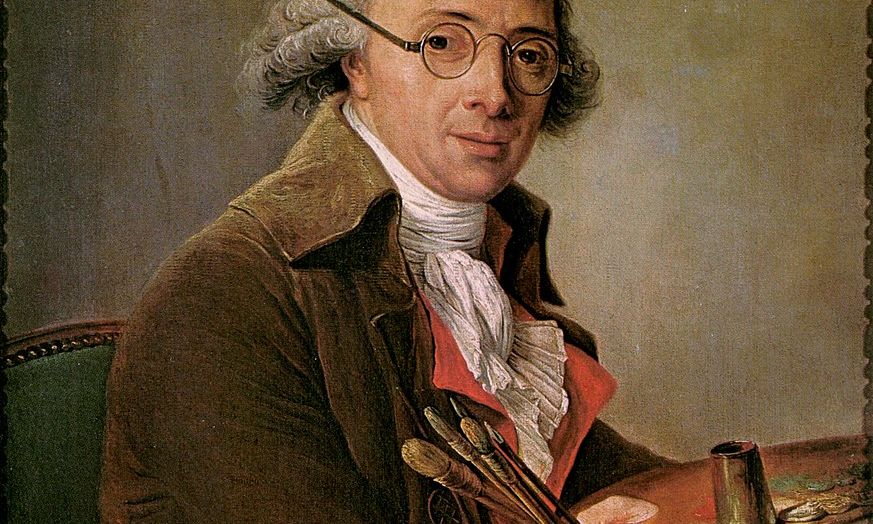Objects such as François-André Vincent’s glasses are illuminated through histories of reading, of seeing and of measuring time
Portrait of the painter Francois Andre Vincent (1746-1816), 18th century (oil on canvas). Wikimedia commons
This book is joyous, innovative and deeply collaborative. Artists’ Things: Rediscovering Lost Property from Eighteenth-Century France brings out into the light, from an ingenious array of hiding places (including pockets and drawers, inventories and police records), objects that once belonged to 18th-century French artists, long concealed from historical view. As the authors explain, we think about artists in such a disembodied way that we rarely consider the everyday things they owned.
As original as its subject, the book’s form (available free online, with zoomable illustrations and other dimensions unique to the digital format) is an invigorating challenge to the dominance of the genre of artists’ lives. Its short, object-centred chapters will appeal to fans of Neil MacGregor’s A History of the World in 100 Objects (2010), but its hierarchy-busting alphabetical order (by object, not artist) puts it into conversation with the quintessentially 18th-century modes of dictionaries and encyclopaedias. It does not share Diderot and d’Alembert’s aim of synthesis but, with its interwoven taxonomies, indexes and cross-references, it converses with their Encyclopédie and a world of wordsmiths and thinkers as well as producers and consumers of material goods. Katie Scott and Hannah Williams have fun with the order;“Dressing-Up Box”, with a thrilling evocation of Antoine Watteau’s response to the behaviour of cloth on the surface of the human body, is immediately followed by “Ecorché” and Jean-Antoine Houdon’s depiction of the human body stripped of its skin. “Will” is followed by “Wine”, to cheer the reader on their way.
Both authors write beautifully and distinctively. They worked over many years exploring the physicality of objects, opening boxes, unfolding documents, touching, smelling, listening to objects, “understanding our things in action”. Their intense scrutiny pays off. Jean-Baptiste Greuze and his wife did not share the same quill pen when they signed the document separating their goods at the end of their marriage; the sword with which François Lemoyne died by suicide had a low-quality hilt but a blade that was top of the line.
The implications of objects in space are significant, from the orientation of Antoine Coypel’s bed in a room, to the layout of Parisian streets. The authors consider the interaction of objects with the body: Elisabeth Vigée-Lebrun’s palette held in one hand, versus the two-handed performance of Jean-Baptiste Oudry’s snuff box; the motor control demanded by a crayon and how Houdon distributed his weight against his modelling stand.
Contrastingly, these objects also give riveting access to the institutions that shaped artistic experience and identity, not least the Académie’s ritualised practices and interpersonal rivalries expressed by a document box. The book keeps circling back to the corridors, studios and private spaces of the Louvre: a bath, a key and a lantern have as much to say about the place as a tool of reform or control as about an artist’s domestic life.
Artists’ Things will delight non-specialists, scholars and students alike. Jargon-free, it engages with fundamental historical debates about production, consumption and sociability, and learns from disciplines including anthropology and economics, bringing a vast range of cultural contexts to bear. There are useful accounts, for example, of 18th-century thinking about animals as things (or not)—Joseph Siffred Duplessis’s dog; Marie-Anne Collot’s nightingale, a gift from Catherine II—and about luxury (local for Jean-Baptiste Pigalle’s carriage, global for Jean-Étienne Liotard’s gaming set). Objects are illuminated through histories of reading, of seeing (François-André Vincent’s glasses) and of measuring time. Of particular interest to historians of collecting, François Boucher’s shells and Charles-Joseph Natoire’s intaglios challenge established narratives. Louis-Michel van Loo’s robe de chambre is full of counterintuitive information about artistic dress (the book is brilliant on clothes) and the labour to be found in Jean-Honoré Fragonard’s colour box in counterbalance to the sprezzatura with which he tends to be identified. We learn about the gendering of the engraver’s burin, about the chemistry of pigments, about postal systems and the management of (Jean-Siméon Chardin’s) domestic water supply. Hyacinthe Rigaud’s relic of the true cross—no less holy because he could own it—is just one example of the sacred in a book that, for all its apparent modesty, encompasses an awful lot of human life.
The chapters on written things, from journal to order book to documents marking personal and professional rites of passage, bring their thingness to life and are a masterclass in the challenges and pleasures of the best archival research. Inviting readers to disagree with their interpretation, the authors speculate on artists’ interior lives, emboldening readers to do the same, armed with the book’s scrupulous attention to the limitation of the evidence whose materiality they so eloquently conjure.
Grasped vividly in the present, artists’ things are also followed into their afterlives. The metal plaque fixed to a table that Jacques-Louis David depicted in the imaginary space of a painting, and which visitors to his studio were later invited to encounter as an actual thing, is just one example of an 18th-century object pulled into a world more familiar from 19th-century commemoration of genius through the enshrinement of artists’ things.
• Artists’ Things: Rediscovering Lost Property from Eighteenth-Century France, by Katie Scott and Hannah Williams. Published 9 January by Getty, 374pp, 140 colour & 50 b/w illustrations, $60 (pb) free online

